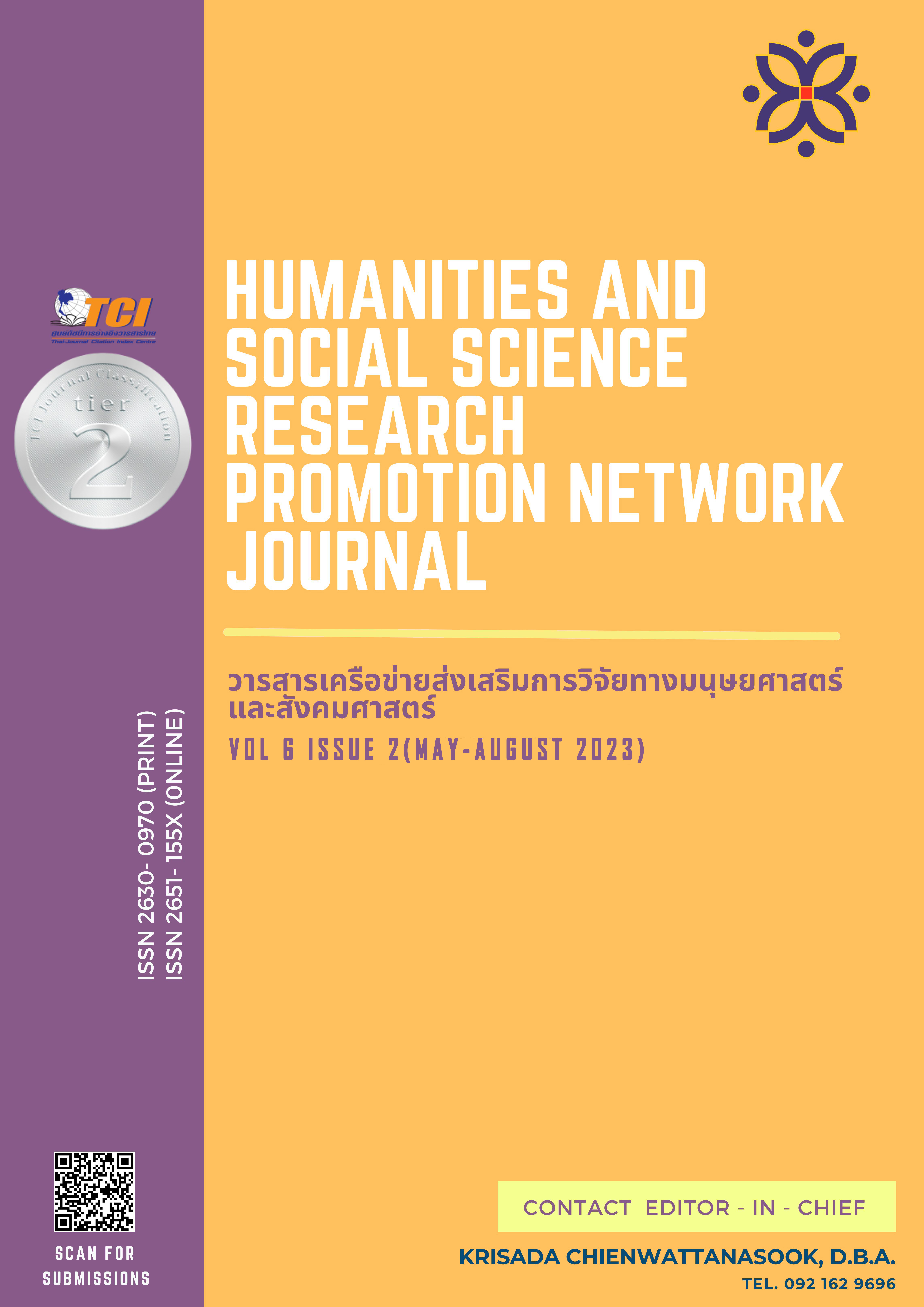ตลาดหลักทรัพย์มีปฏิกิริยาอย่างไรต่อการเปลี่ยนแปลงทางการเมือง
คำสำคัญ:
ความผันผวนของตลาดหลักทรัพย์ , แบบจำลองจีเจอาร์การ์ช , การเปลี่ยนแปลงทางการเมืองบทคัดย่อ
การศึกษานี้ศึกษาปฏิกิริยาของตลาดหลักทรัพย์ต่อการเปลี่ยนแปลงทางการเมืองในประเทศไทยตั้งแต่วันที่ 1 ตุลาคม 2556 ถึง 12 เมษายน 2566 โดยอาศัยแบบจำลองเชิงประจักษ์ ได้แก่ แบบจำลอง GJR-GARCH (1,1) เพื่อตรวจสอบความผันผวนของผลตอบแทนตลาดหลักทรัพย์ โดยแบ่งช่วงเวลาสำหรับการศึกษาออกเป็น 5 ช่วงทั้งก่อนและหลังการเปลี่ยนแปลงทางการเมือง ผลการศึกษาพบว่าความไม่แน่นอนทางการเมืองในประเทศไทยส่งผลลบต่อความผันผวนของตลาดหลักทรัพย์ ซึ่งบ่งชี้ว่าความผันผวนของตลาดหลักทรัพย์เกิดจากข่าวร้ายมากกว่าข่าวดีจากสถานการณ์การเปลี่ยนแปลงทางการเมือง โดยมีหลักฐานเชิงประจักษ์คือค่าแกมม่ามีค่าเป็นบวกอย่างมีนัยสำคัญในแบบจำลอง GJR-GARCH ดังนั้นในช่วงดังกล่าวตลาดหลักทรัพย์จึงเกิดภาวะดัชนีเป็นขาลงส่งผลให้ผลตอบแทนติดลบ
เอกสารอ้างอิง
Apergis, N., Mustafa, G., & Malik, S. (2022). COVID-19 pandemic, stock returns, and volatility: the role of the vaccination program in Canada. Applied Economics, 54(42), 4825-4838.
Baker, S. R., & Bloom, N. (2013). Does uncertainty reduce growth? Using disasters as natural experiments. National Bureau of Economic Research. Working Paper 19475.
Baxter, M., & Jermann, U. (1997). The international diversification puzzle is worse than you think. The American Economic Review, 87(1), 170-180.
Białkowski, J., Gottschalk, K., & Wisniewski, T. P. (2008). Stock market volatility around national elections. Journal of banking & finance, 32(9), 1941-1953.
Bollerslev, T. (1986). Generalized autoregressive conditional heteroskedasticity. Journal of econometrics, 31(3), 307-327.
Bouri, E., Naeem, M. A., Nor, S. M., Mbarki, I., & Saeed, T. (2022). Government responses to COVID-19 and industry stock returns. Economic Research-Ekonomska Istraživanja, 35(1), 1967-1990.
Buckley, R. P., Arner, D. W., Zetzsche, D. A., & Selga, E. (2019). The dark side of digital financial transformation: The new risks of fintech and the rise of techrisk. UNSW Law Research Paper(19-89).
Chau, F., Deesomsak, R., & Wang, J. (2014). Political uncertainty and stock market volatility in the Middle East and North African (MENA) countries. Journal of International Financial Markets, Institutions and Money, 28, 1-19.
Danielsson, J., Macrae, R., & Uthemann, A. (2022). Artificial intelligence and systemic risk. Journal of banking & finance, 140, 106290.
Engle, R. F., & Ng, V. K. (1993). Measuring and testing the impact of news on volatility. the Journal of Finance, 48(5), 1749-1778.
Festić, M., Kavkler, A., & Repina, S. (2011). The macroeconomic sources of systemic risk in the banking sectors of five new EU member states. Journal of banking & finance, 35(2), 310-322.
Ghani, M., Guo, Q., Ma, F., & Li, T. (2022). Forecasting Pakistan stock market volatility: Evidence from economic variables and the uncertainty index. International Review of Economics & Finance, 80, 1180-1189.
Glosten, L. R., Jagannathan, R., & Runkle, D. E. (1993). On the relation between the expected value and the volatility of the nominal excess return on stocks. the Journal of Finance, 48(5), 1779-1801.
Hartwell, C. A. (2018). The effect of political volatility on capital markets in EU accession and neighborhood countries. Journal of Economic Policy Reform, 21(4), 260-280.
Hillier, D., & Loncan, T. (2019). Political uncertainty and stock returns: Evidence from the Brazilian political crisis. Pacific-Basin Finance Journal, 54, 1-12.
Koulakiotis, A., Papapanagos, H., & Papasyriopoulos, N. (2016). Political elections, abnormal returns and stock price volatility: the case of Greece. Investment Management and Financial Innovations, 13(1-1), 161-169.
Lean, H. H., & Yeap, G. P. (2016). Asymmetric effect of political elections on stock returns and volatility in Malaysia. In Information Efficiency and Anomalies in Asian Equity Markets (pp. 246-263). Routledge.
Lin, C., & Wang, Y. (2005). An analysis of political changes on Nikkei 225 stock returns and volatilities. Annals of Economics and Finance, 6(1), 169.
Markowitz, H. M. (1952). Portfolio Selection. The Journal of Finance, 7(1), 77-91.
Nelson, D. B. (1990). ARCH models as diffusion approximations. Journal of econometrics, 45(1-2), 7-38.
Olweny, T., & Omondi, K. (2011). The effect of macro-economic factors on stock return volatility in the Nairobi stock exchange, Kenya. Economics and Finance review, 1(10), 34-48.
Sharpe, W. F. (1964). Capital asset prices: A theory of market equilibrium under conditions of risk. the Journal of Finance, 19(3), 425-442.
Tiwari, A. K., Trabelsi, N., Alqahtani, F., & Raheem, I. D. (2020). Systemic risk spillovers between crude oil and stock index returns of G7 economies: Conditional value-at-risk and marginal expected shortfall approaches. Energy Economics, 86, 104646.
Yeh, Y.-H., & Lee, T.-S. (2000). The interaction and volatility asymmetry of unexpected returns in the greater China stock markets. Global Finance Journal, 11(1-2), 129-149.
ดาวน์โหลด
เผยแพร่แล้ว
รูปแบบการอ้างอิง
ฉบับ
ประเภทบทความ
สัญญาอนุญาต
ลิขสิทธิ์ (c) 2023 นรเศรษฐ ศรีธานี

อนุญาตภายใต้เงื่อนไข Creative Commons Attribution-NonCommercial-NoDerivatives 4.0 International License.
บทความที่ได้รับการตีพิมพ์เป็นลิขสิทธิ์ของ ผู้เขียน
ทัศนะและความคิดเห็นที่ปรากฏในบทความในวารสารเครือข่ายส่งเสริมการวิจัยทางมนุษยศาสตร์และสังคมศาสตร์จะถือเป็นความรับผิดชอบของผู้เขียนบทความนั้น และไม่ถือเป็นทัศนะและความรับผิดชอบของกองบรรณาธิการ








